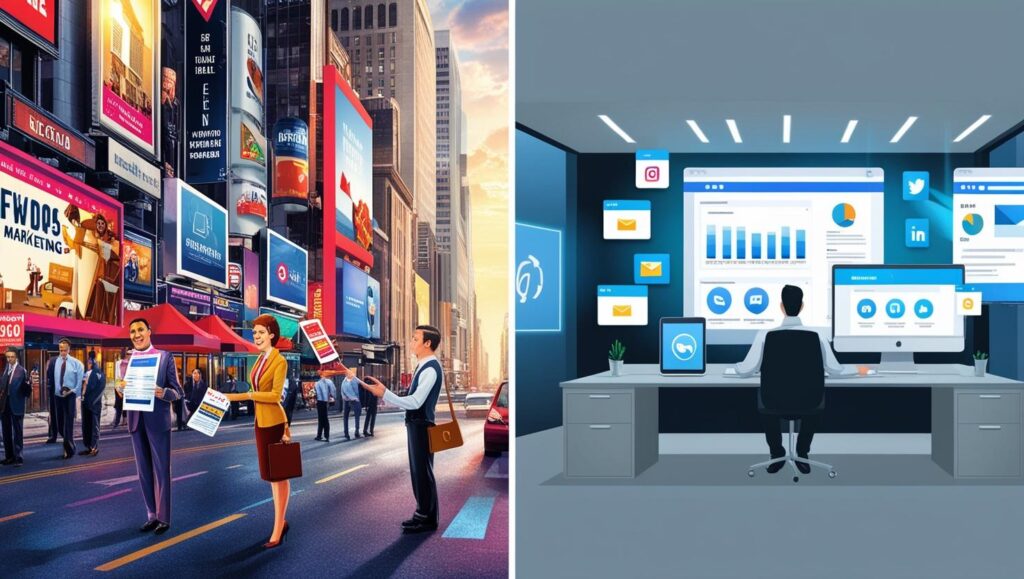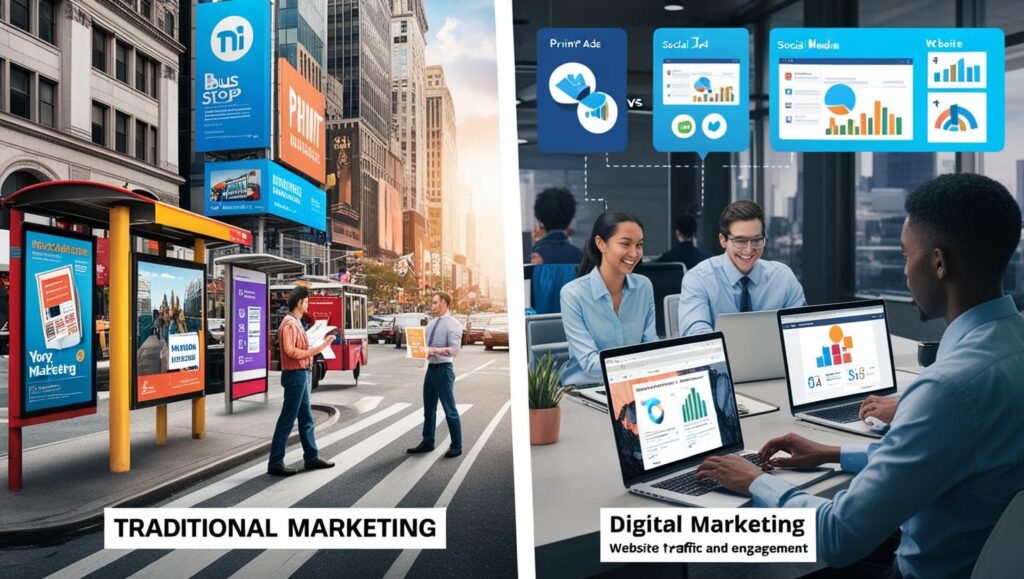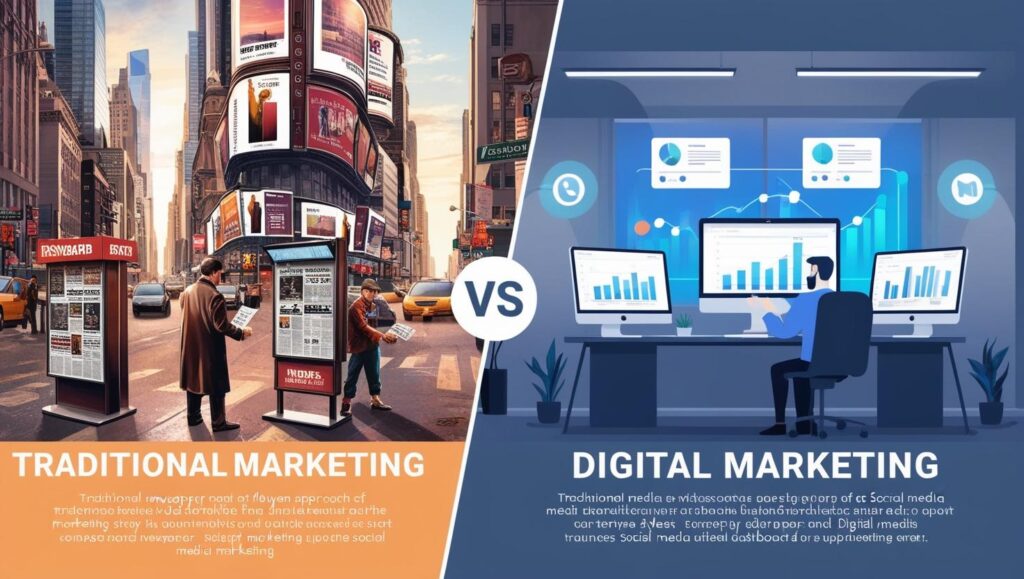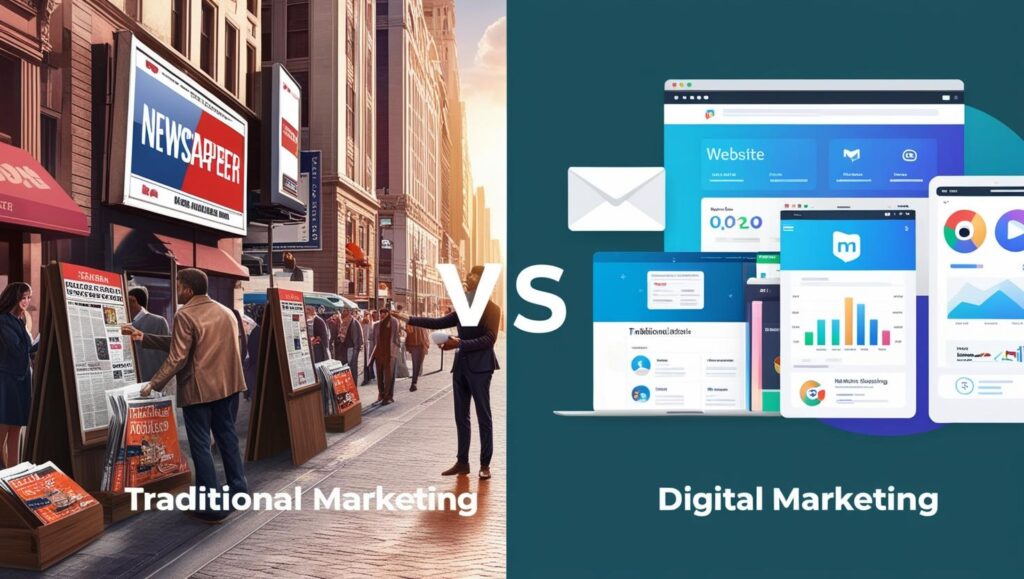In today’s fast-paced, technology-driven world, businesses have more options than ever when it comes to marketing. But one question still puzzles many entrepreneurs and marketers: Traditional marketing vs. digital marketing — which one should you choose?
This comprehensive guide explores the key differences, pros, and cons of both marketing approaches, helping you make the right decision for your brand.
What is Traditional Marketing?

Traditional marketing refers to any type of marketing that is not online. It’s the age-old way of reaching customers using physical methods such as:
- TV and radio commercials
- Newspaper and magazine ads
- Billboards and signage
- Flyers and brochures
- Direct mail
Advantages of Traditional Marketing
- Wide Reach for Local Audiences: Great for businesses targeting a local demographic.
- Tangible and Trustworthy: Physical materials like flyers and print ads build credibility.
- Memorable Impact: TV and billboard ads can leave a lasting impression.
- No Internet Required: Perfect for customers who are not tech-savvy or don’t use the internet frequently.
Limitations of Traditional Marketing
- Expensive: TV, print, and radio ads can be costly, especially for small businesses.
- Limited Interaction: Traditional ads are one-way communication.
- Hard to Measure ROI: Tracking the effectiveness of a billboard or radio ad is challenging.
- Less Targeted: It’s difficult to fine-tune your message for specific audience segments.
What is Digital Marketing?
Digital marketing is the promotion of products or services using digital channels and the internet. It includes:
- Search Engine Optimization (SEO)
- Social Media Marketing (SMM)
- Email Marketing
- Content Marketing (blogs, videos, etc.)
- Pay-Per-Click (PPC) Advertising
- Affiliate and Influencer Marketing
Advantages of Digital Marketing
- Cost-Effective: Start with a small budget and scale as you grow.
- Real-Time Analytics: Easily track performance through tools like Google Analytics.
- Highly Targeted: Reach specific demographics based on behavior, interests, and location.
- Global Reach: Expand your business beyond borders without spending a fortune.
- Two-Way Communication: Engage with your audience through comments, likes, and shares.
Limitations of Digital Marketing
- Highly Competitive: Standing out in a crowded digital space can be tough.
- Constant Learning Curve: Algorithms and platforms keep evolving.
- Requires Consistent Effort: You need to maintain a regular online presence.
- Ad Fatigue: Users may ignore repetitive ads or use ad blockers.

Traditional Marketing vs. Digital Marketing: Key Differences
| Feature | Traditional Marketing | Digital Marketing |
|---|---|---|
| Medium | Print, TV, Radio, Outdoor | Internet, Mobile, Social Media |
| Audience Reach | Local/National | Local/Global |
| Interactivity | One-way communication | Two-way interaction |
| Cost | Generally high | Budget-friendly and scalable |
| Tracking & Analytics | Difficult to measure | Real-time, in-depth tracking |
| Engagement | Limited | Highly engaging |
| Targeting Capabilities | Broad and general | Laser-focused targeting options |
| Longevity | Short-term unless renewed | Evergreen content can last for years |
When to Use Traditional Marketing
Traditional marketing isn’t obsolete — in fact, it still works well in certain scenarios:
- Targeting older audiences
- Promoting local brick-and-mortar stores
- Participating in trade shows or community events
- Establishing strong brand presence in a local market
- Launching high-impact ad campaigns on TV or radio
When to Use Digital Marketing
Digital marketing is a smart choice for:
- Reaching a younger, tech-savvy audience
- Building brand awareness online
- Generating leads and driving website traffic
- Engaging customers through social media
- Tracking campaigns and optimizing for ROI

The Power of Integration: Traditional and Digital
In reality, a hybrid marketing strategy often brings the best results. Businesses that combine both approaches can:
- Reach a wider audience across different platforms
- Build trust through offline visibility while nurturing leads online
- Boost brand recognition by reinforcing messages across multiple channels
Examples of Integrated Marketing
- A flyer with a QR code leading to a website
- A TV commercial promoting a social media contest
- Billboards featuring a website URL or social media handle
- Email campaigns that invite customers to visit a physical event
Final Verdict: Which One Wins?
There’s no one-size-fits-all answer to the traditional vs. digital marketing debate. The right strategy depends on:
- Your target audience
- Your marketing budget
- Your business goals
- Your industry trends
Quick Summary:
- Choose traditional marketing if you want strong local visibility and offline brand credibility.
- Go for digital marketing if you’re focused on cost-effectiveness, measurable results, and long-term scalability.
- Use both if your audience spans different age groups or locations.
Final Thoughts
Whether you choose traditional marketing, digital marketing, or a mix of both, the key is to understand your audience and craft a message that resonates. In the age of digital transformation, staying flexible and adaptable will ensure that your marketing strategy remains effective and future-proof.
If you’re looking to boost your digital presence and stay ahead of the competition, consider starting with simple digital tactics like SEO, social media, or email campaigns.

Need help with digital marketing?
At Digital Deepika, we specialize in helping businesses grow online with smart, scalable digital marketing strategies. Contact us today to get started!
